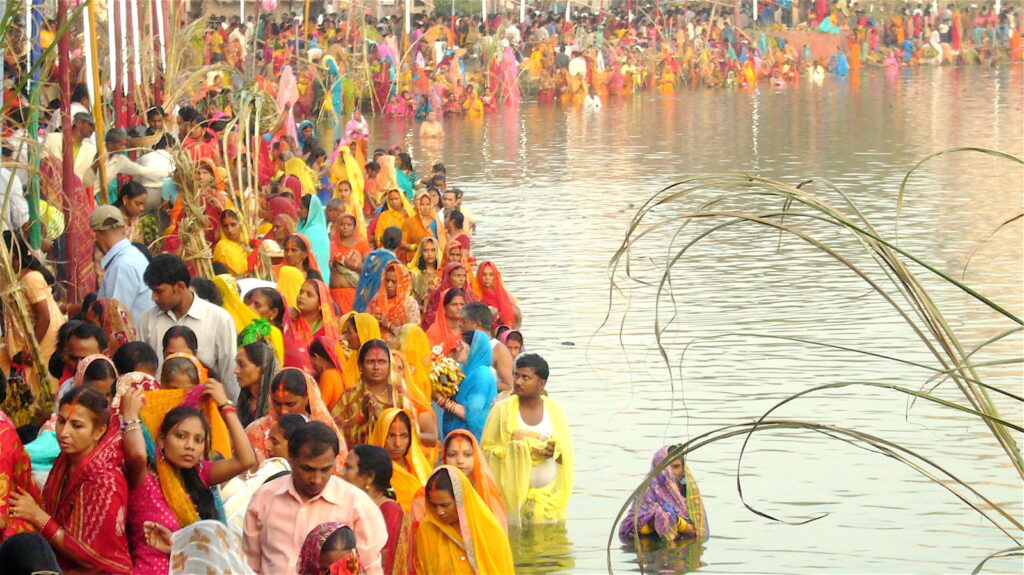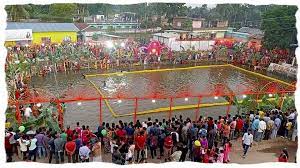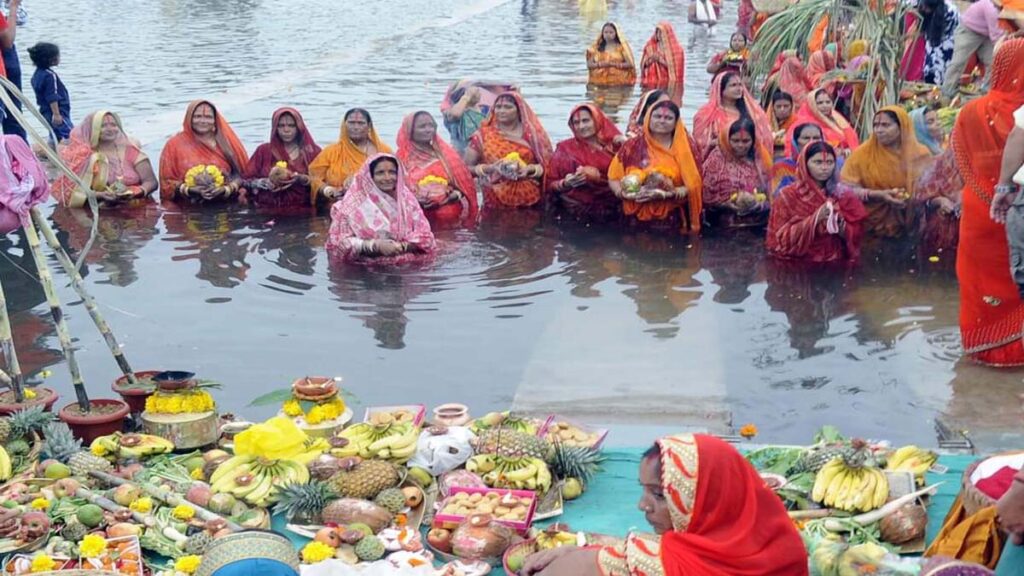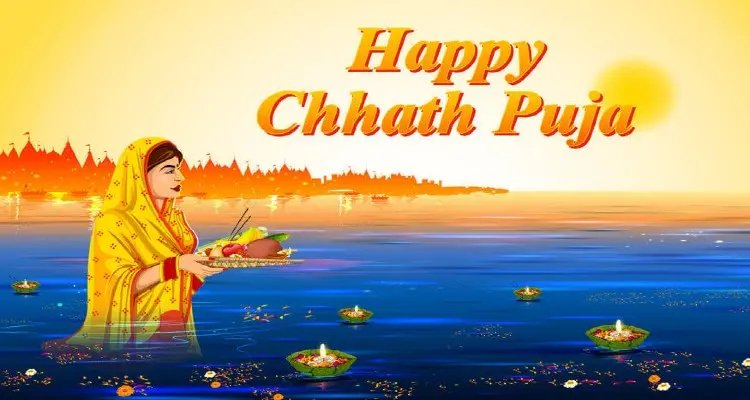Chhath festival, Chhaith or Shashthi Puja is a Hindu festival celebrated on Shashthi of Kartik Shukla Paksha. This unique folk festival of sun worship is mainly celebrated in the Terai areas of Bihar, Jharkhand, West Bengal, Eastern Uttar Pradesh and Nepal. It is said that this festival is the biggest festival of Maithil, Magadha and Bhojpuri people, it is their culture. Chhath festival is celebrated with great pomp in Bihar. This is the only festival of Bihar or entire India which has been going on since the Vedic period and has become the culture of Bihar. The festival here shows a small glimpse of the Vedic Aryan culture of Bihar. This festival is mainly celebrated here in Bihar according to Sun worship, Usha worship and Arya tradition in Rigveda written by sages.

History
Some say that Chhath Puja is the oldest festival that may even precede the Ancient Vedas as the Rigveda contains hymns of worshipping the Sun and some similar rituals as followed in this festival. These rituals also have a mention in the Mahabharata where Draupadi is portrayed performing similar rituals. On the advice of astute Dhaumya, the rituals of Chhath were followed by the Pandavas and Draupadi. This worshipping of the Sun solved many problems of Draupadi and later helped the Pandavas to regain their kingdom. The scientific or yogic history of this festival dates back to the Vedic times when the scholars or rishis of yore used this technique to remain without food as they used to absorb energy from the rays of the sun. This was known as Chhath Method. Some ancient also suggest that Lord Rama and Sita kept fast and offered puja to the sun in the Kartika month during the Shukla Paksha during their coronation after returning from the exile.
Significance Of Chhath Puja
During Chhath Puja, women keep fast for 36 hours to get blessings from Lord Surya and Chhathi Maiya. The first day of Chhath is called Nahay Khay – devotees take bath in holy waters like river Ganga, women observing Chhath observe Nirjala fast and devotees prepare offerings to Lord Surya. The second and third days are called Kharna and Chhath Puja. Women observe a strict Nirjala fast these days. Along with this, on the fourth day (Usha Arghya), women stand in water and offer Arghya to the rising sun and then break their 36-hour fast.

Festival of folk faith
This four-day festival of folk faith is starting on 17th November this year. Preparations for Chhath festival are now in the final stages and there is a lot of enthusiasm among the people to celebrate this festival. There is a lot of crowd and excitement in the local markets regarding the festival.

How is Chhath festival celebrated
India is a country of festivals where every festival is celebrated with utmost enthusiasm and devotion. One of the most important festivals, which is celebrated exactly a week after Diwali, is Chhath Puja. This festival occurs on Kartik Shukla Shashthi, which is the sixth day of Kartik month according to the Hindu calendar. This four-day long festival is of great importance and is celebrated with great enthusiasm and excitement mainly in the states of Jharkhand, Uttar Pradesh, Odisha and West Bengal Bihar in India. Devotees celebrate the festival by observing a fast and worshiping the god of light, energy and vitality i.e. Sun God and his consort Usha, also known as Chhathi Maiya. It is believed that worshiping the Sun brings longevity, positivity, prosperity and well-being.

form of celebration
Chhath Puja is a four-day festival. It starts on Kartik Shukla Chaturthi and ends on Kartik Shukla Saptami. During this period, the devotees observe a fast for 36 hours continuously. During this period they do not even consume water.
Bathing and eating
The first day of Chhath festival, which is known as ‘Nahay-Khay’, begins with Kartik Shukla Chaturthi, the Chaturthi of Chaitra or Kartik month. First of all, the house is cleaned and sanctified. After that, the devotees go to the nearby river Ganga, tributary of Ganga or pond and take bath. On this day, fasting people take bath after cutting their nails etc. thoroughly and washing their hair thoroughly with clean water. While returning, they bring Ganga water with them which they use for cooking. They keep the surroundings of their house clean and tidy. The fasting person eats food only once on this day. The fasting people use pumpkin vegetable, mung gram dal, rice in their food. Fried puris, parathas, vegetables etc. are prohibited. This food is cooked in bronze or earthen utensils. Mango wood and earthen stove are used for cooking. When the food is prepared, the fasting person eats it first and only then other family members eat it.

Kharna and Lohanda
The vratis observe Nirjala fast (fast without drinking even a drop of water) from sunrise to sunset. They break their fast only after worshipping the sun during the sunset. The devotees prepare many offerings like sweets, mainly kheer, bananas and rice. After consuming the prasad one has to fast for 36 hours without water.

Evening prayer
The third day of Chhath festival, known as Sandhya Arghya, is celebrated on Chaitra or Kartik Shukla Shashthi. The whole day everyone prepares for the puja together. Special Prasad like Thekua, rice laddus also known as Kachvaniya are made for Chhath Puja. For Chhath Puja, puja offerings and fruits are put in a basket made of bamboo called Daura and kept in Devkari. After offering puja there, in the evening, in a soup, coconut, five types of fruits and other puja items are kept in Daura and the man of the house picks it up with his hands and takes it to Chhath Ghat. To prevent it from becoming impure, it is kept above the head. Women often sing Chhath songs on the way to Chhath Ghat.

Usha Arghya
On the fourth day, on the morning of Kartik Shukla Saptami, Arghya is offered to the rising sun. Even before sunrise, the fasting people reach the ghat to worship the rising Sun God and like in the evening, their ancestors and relatives are present. The dishes offered in the evening Arghya are replaced with new dishes but the tubers, roots and fruits remain the same. All the rules and regulations are like the evening Arghya. Only fasting people at this time stand in water facing east and worship the sun. After the puja, the ghat is worshipped. After distributing Prasad among the people present there, the fasting people come home and also distribute Prasad to their families etc. at home. After returning home, the devotees go to the Peepal tree of the village which is called Brahma Baba and worship there. After the puja, the devotees complete their fast by drinking raw milk sherbet and eating some prasad, which is called Paran or Parna. The fasting people, after fasting without water from Kharna day till today, eat salty food only in the morning.

Fast
At the center of Chhath festival is Chhath Vrat which is like a difficult penance. This Chhath fast is mostly observed by women; Some men also observe this fast. Women who observe fast are called Parvaitin. During this fast of four days, the devotee has to fast continuously. Along with food, a comfortable bed is also sacrificed. In the room built for the festival, the devotees spend the night on the floor with the support of a blanket or sheet. People participating in this festival wear new clothes. It is mandatory for the fasting person to wear such clothes which do not have any kind of stitching. Women celebrate Chhath wearing saree and men wearing dhoti. ‘After starting Chhath festival, it has to be celebrated for years until a married woman of the next generation is ready for it. This festival is not celebrated if someone dies in the house.

